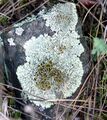Biology:Xanthoparmelia
| Xanthoparmelia | |
|---|---|

| |
| Xanthoparmelia conspersa | |
| Scientific classification | |
| Domain: | Eukaryota |
| Kingdom: | Fungi |
| Division: | Ascomycota |
| Class: | Lecanoromycetes |
| Order: | Lecanorales |
| Family: | Parmeliaceae |
| Genus: | Xanthoparmelia (Vain.) Hale (1974) |
| Type species | |
| Xanthoparmelia conspersa (Ehrh. ex Ach.) Hale (1974)
| |
| Synonyms[1] | |
|
List
| |
Xanthoparmelia (commonly known as green rock shields or rock-shield lichens) is a genus of foliose lichen in the family Parmeliaceae.[2][3]:134 Xanthoparmelia is synonymous with Almbornia, Neofuscelia, Chondropsis, Namakwa, Paraparmelia, and Xanthomaculina.[4] This genus of lichen is commonly found in the United States, as well as Australia, New Zealand and Ecuador.
The name means 'golden yellow parmelia'. The photobiont (photosynthetic partner) is Trebouxia (a genus of green algae).
Identification
Distinguishing between species involves how much they are attached to the substrate, whether or not isidia are present, lower surface color, and chemical spot tests.[3]:134 All members of the genus react to spot test as K−, KC+ yellow, with medulla reaction varying from species to species.[3]:134
Species
Species include:
- Xanthoparmelia chlorochroa
- Xanthoparmelia conspersa (Parmelia conspersa)
- Xanthoparmelia cumberlandia
- Xanthoparmelia lavicola - a foliose (leaf-like) lichen found on basalt[5]
- Xanthoparmelia lineola
- Xanthoparmelia maricopensis
- Xanthoparmelia mexicana
- Xanthoparmelia metastrigosa[6]
- Xanthoparmelia mougeotii (Parmelia mougeotii)
- Xanthoparmelia nana
- Xanthoparmelia pokornyi
- Xanthoparmelia subramigera
- Xanthoparmelia scabrosa
- Xanthoparmelia tinctina
Taxonomy
Xanthoparmelia was originally conceived of as a section of the genus Parmelia by Brazilian lichenologist Edvard August Vainio in 1890, to accommodate yellow species with narrow lobes.[7] Mason Hale considered that the combination of traits including the presence of the cortical pigment usnic acid, and the microscopic structure of the upper cortex were sufficient criteria to segregate Xanthoparmelia from the genus Parmelia. He formally transferred 93 species, including the type, Xanthoparmelia conspersa.[8]
In a 2004 study, molecular analysis was used to help revise the classification of parmelioid lichens containing Xanthoparmelia-type lichenan. This analysis demonstrated that several genera previously segregated from Xanthoparmelia on the basis of physical characteristics did not form distinct clades within Xanthoparmelia, and so Neofuscelia, Chondropsis and Paraparmelia were synonymized with Xanthoparmelia. As a result of this work, 10 new species were published, and 129 new combinations into Xanthoparmelia were proposed.[9] Similarly, three south African genera, Almbornia, Namakwa, and Xanthomaculina, were synonymized with Xanthoparmelia after the limits of the genus were further explored and refined with molecular phylogenetics.[10] Karoowia, a genus that was characterized by features such as its subcrustose growth form and its presence of an arachiform vacuolar body in the ascospores, was synonymised with Xanthoparmelia when it was shown that its species cluster in different clades nested within Xanthoparmelia.[11] The genus Omphalodiella, proposed by Aino Henssen in 1991 to contain the Patagonian species Omphalodiella patagonica,[12] has since been shown to lie within Xanthoparmelia.[13]
Gallery
Xanthoparmelia subramigera growing on an asphalt shingle roof in Maryland, United States
References
- ↑ "Synonymy: Xanthoparmelia (Vain.) Hale, Phytologia 28(5): 485 (1974)". Species Fungorum. http://www.speciesfungorum.org/Names/SynSpecies.asp?RecordID=5805.
- ↑ "Metagenomic data reveal diverse fungal and algal communities associated with the lichen symbiosis". Symbiosis 82 (1–2): 133–147. 2020. doi:10.1007/s13199-020-00699-4.
- ↑ 3.0 3.1 3.2 Field Guide to California Lichens, Stephen Sharnoff, Yale University Press, 2014, ISBN:978-0-300-19500-2
- ↑ Lumbsch TH, Huhndorf SM. (December 2007). "Outline of Ascomycota – 2007". Myconet (Chicago, USA: The Field Museum, Department of Botany) 13: 1–58. http://archive.fieldmuseum.org/myconet/outline.asp.
- ↑ Dobson, Frank S (2005). Lichens An Illustrated Guide to the British and Irish Species. The Richmond Publishing Co.Ltd. pp. 459–460. ISBN 978-0-85546-095-2.
- ↑ Hale Jr, M.E. 1984. New species of Xanthoparmelia (Vain.) Hale (Ascomycotina: Parmeliaceae). Mycotaxon. 20(1):73-79
- ↑ Vainio, E. (1890) (in la). Lichens of Brazil. Acta Societatis pro Fauna et Flora Fennica. 7. Helsinki: Heredum J. Simelii. p. 60. https://www.biodiversitylibrary.org/page/4458203.
- ↑ Hale, Mason E. (1974). "Bulbothrix, Parmelina, Relicina, Xanthoparmelia, four new genera in the Parmeliaceae (Lichenes)". Phytologia 28 (5): 479–490. https://www.biodiversitylibrary.org/page/13046479.
- ↑ Blanco, Oscar; Crespo, Ana; Elix, John A.; Hawksworth, David L.; Lumbsch, H. Thorsten (2004). "A molecular phylogeny and a new classification of parmelioid lichens containing Xanthoparmelia-type lichenan (Ascomycota: Lecanorales)". Taxon 53 (4): 959–975. doi:10.2307/4135563.
- ↑ Thell, Arne; Tassilo, Feuerer; Elix, John A.; Kärnefelt, Ingvar (2006). "A contribution to the phylogeny and taxonomy of Xanthoparmelia (Ascomycota, Parmeliaceae)". Journal of the Hattori Botanical Laboratory 100: 797–807. doi:10.18968/jhbl.100.0_797.
- ↑ Amo de Paz, Guillermo; Lumbsch, H. Thorsten; Cubas, Paloma; Elix, John A.; Crespo, Ana (2010). "The genus Karoowia (Parmeliaceae, Ascomycota) includes unrelated clades nested within Xanthoparmelia". Australian Systematic Botany 23 (3): 173. doi:10.1071/SB09055.
- ↑ Henssen, Aino (1991). "Omphalodiella patagonica, a new peltate lichen genus and species from South America". The Lichenologist 23 (4): 333–342. doi:10.1017/s002428299100049x.
- ↑ de Paz, Guillermo Amo; Lumbsch, H. Thorsten; Cubas, Paloma; Elix, John A.; Crespo, Ana (2010). "The morphologically deviating genera Omphalodiella and Placoparmelia belong to Xanthoparmelia (Parmeliaceae)". The Bryologist 113 (2): 376–386. doi:10.1639/0007-2745-113.2.376.
Wikidata ☰ Q9397450 entry
 |




